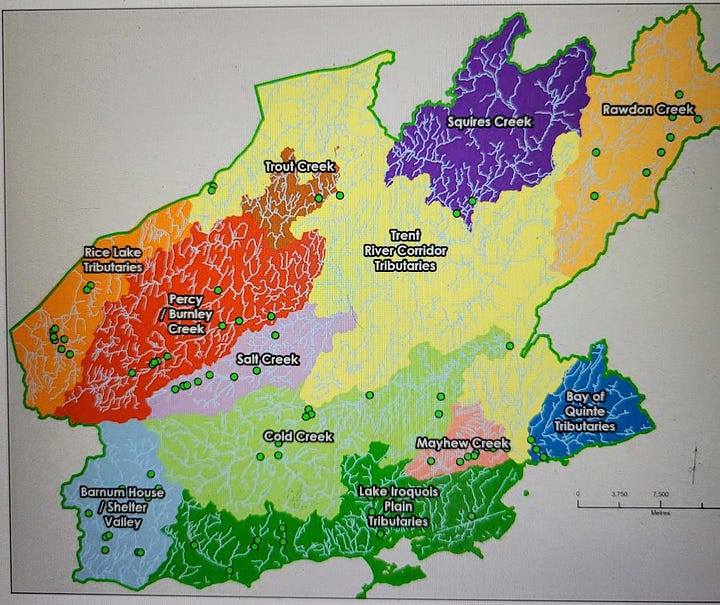Call it Trout-less Creek
Study finds brook trout in Salt, Burnley, and Cold creeks, but none in Trout
Last summer, scientists from Lower Trent Conservation Authority went looking for brook trout in the various rivers that flow into the Trent.
They found several in Cold Creek, especially in its protected section of the Goodrich-Loomis Conservation Area and in Salt Creek. But a check of two locations on Trout Creek, which flows from the west and empties into the Trent in Campbellford, just north of Canadian Tire.
Given that the creek flows through an agricultural area it is “unlikely to support brook trout populations, despite the name,” says a report by Massimo Narini, Watershed Services Specialist with Lower Trent.
The absence of trout would not really surprise anyone who has seen the concrete walls that channel Trout Creek into the Trent, or who has walked or ridden along the ATV trail west of town and seen how the creek flows through open farmland. It’s not a trout-friendly environment.
Brook trout are the fish equivalent of a canary in a cold mine. They require cold, clear, fast running water with lots of shade, and little pollution or sediment in the water. The need for those conditions and their absence explains why brook trout are considered extirpated in most of Southern Ontario, certainly anywhere in the Greater Toronto Area. Extirpated is a fancy word for not there.
“In southern Ontario, brook trout populations have seen an 80% decline in their numbers over the last 50 years,” says the Ontario Rivers Alliance says on its website. “Their populations have been under increasing pressure from a warming climate as well as agricultural, urban, rural and industrial development,”
But no one had studied brook trout in our area, until last year when the Lower Trent decided to go looking. But the conservationists didn’t just peer into the water, or cast a line and see what they caught, instead they used several underwater cameras to explore the creeks.
Narini’s presentation to the board of the Lower Trent Conservation Authority said that between July and October last year the study looked at 81 sites and found brook trout in 40. It had eliminated other sites that were clearly not likely to hold brook trout and didn’t bother sampling them.
The study found trout in seven of eight locations on Salt Creek, seven of nine in Percy Creek/Burnley Creek and five of 10 spots on Cold Creek.
The study used on GoPro Hero cameras and found they worked OK, but didn’t live up to their promises. Narini’s presentation said researchers had problems with water leaking issues, cameras overheating, inflated file sizes which caused computer problems and needed more computing power for editing.
The brook trout project was funded by the Ontario Federation of Anglers and Hunters Community Conservation grant, the Grassroots Conservation Fund, ECO Canada Wage Subsidy Program and private donations, says a report by Gage Comeau, Manager, Watershed Management, Planning and Regulations.
Narini’s report says that Cold Creek is the second largest watershed in the Lower Trent area, behind only the Trent River itself. He notes that until 1993 the Ministry of Natural Resources stocked the river with brown and brook trout. Much of the lower section of the creek have been altered by agriculture practices and are no longer suitable for trout, but the headwaters remain cold and in a more natural state.
The surveys found brown trout in some areas suggesting the species has managed to sustain itself since stocking stopped 30 years ago.
Salt Creek, which has its headwaters in the Oak Ridges Moraine in the west and flows into the Trent just south of Meyersburg, was “found to be one of the most pristine cold-water sub-watersheds” in the area, Narini wrote.
Several landowners near the headwaters told Narini they are passionate about protecting the fish and have installed fences and signage to keep anglers out.
“Burnley Creek is another healthy cold-water habitat which has relatively undeveloped headwaters and a Lower Trent Conservation property helping to protect a key section of brook trout habitat,” the report says.


You can read all Trent Hills News stories anytime on the website.




As a boy some fifty years ago there was a fish hatchery operated by the M.N.R. At Deer or Cordova lake that raised trout and lunge. They stocked creeks and lakes with fish. There was at busy times up to maybe five employees working there one was my late brother in law. I believe the last operator still lives up there. Two govt. houses and the building and the ponds are still there. There was also a hatchery at Codrington.